On the CardsSunday, 25th July 2004 |
African Wildlife was the first series that I made a serious effort to collect. There was always a frisson of mystery about which card you'd find tucked between the cardboard carton and foil wrapper. It was a disappointment if it was number 25 Black-backed Jackal yet again, but you could always trade surplus cards with your friends at school 'I swopped Robert Bishop for an aardvark today!' I told my Mum excitedly when I got home. 'I bet his mother was pleased!' she said. Ha ha.
|
 |
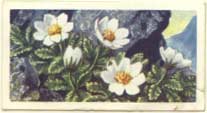 |
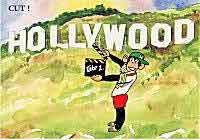 |
1 The Mute Swan |
31 MOUNTAIN AVENS: Dryas octopetala L. A rare and lovely plant to find during mid-summer on certain mountains of the British Isles - but also near sea-level in the north of Scotland and the west of Ireland. Leaves and flowers are equally beautiful, and for such a dwarf shrubby plant the saucer-shaped, pure white flowers are surprisingly large. Later the golden-yellow stamens give way to a mass of silvery plumes over an inch long, which are almost as attractive as the flower. It favours limestone. |
29 Hollywood - America |
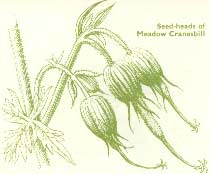 The
last series in 1998, by the way, was International Soccer Stars
which fittingly brought together today's cult of celebrity with an echo
of the early days of collector cards: famous footballers were regularly
featured on cigarette cards from 1900 to 1950.
The
last series in 1998, by the way, was International Soccer Stars
which fittingly brought together today's cult of celebrity with an echo
of the early days of collector cards: famous footballers were regularly
featured on cigarette cards from 1900 to 1950.
This drawing of the seed-heads of Meadow Cranesbill is from the Wild Flowers album. I think Tunnicliffe's experience in wood engraving is evident in this drawing. It was good to have artwork like this around in my early years. It's hard, now that we're swamped with dazzling images, to realise how unusual these miniature colour cards were at the time. During the period Tunnicliffe was producing his cards all natural history films on television (not to mention the rest of the output) were in black and white.
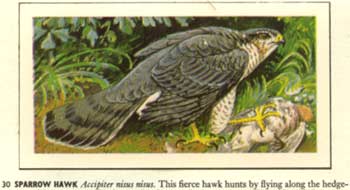 As
I was writing this page I received this e-mail from Pete. I've illustrated
it with a Tunnicliffe tea card from Wild Birds in Britain (1965).
As
I was writing this page I received this e-mail from Pete. I've illustrated
it with a Tunnicliffe tea card from Wild Birds in Britain (1965).
'I was watching the village football team in a pre-season friendly (we won 6-0) when what I at first mistook for a collared dove chasing off a small bird came hurtling over the club-house. This became a sparrowhawk chasing its prey when the small bird was taken in mid air by its pursuer right above the visitors goal. I was the only one to notice this drama of nature and the sparrowhawk took its victim to a strip of grass behind the visitor's dug out. It lifted off again when the away team's manager suddenly spotted it and walked toward it, taking its capture over the hedge into a neighbouring garden.
'It's not the first time I've mistaken a sparrowhawk for a collared dove, they can look remarkably similar flying at speed towards or away from you. What I find remarkable is how oblivious people can be to these acts of nature going on right in their midst.
'I walked over to the where the hawk had landed later but there didn't
seem to be any feathers about to give me a clue to the victims identity.'
![]()
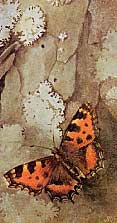 Barnton
& Frodsham A.C., Pete Leicester's angling club.
Barnton
& Frodsham A.C., Pete Leicester's angling club.
spaghoops.com 'No Adverts, No Allegiances, Nowt To Buy, No Pressure'
Martin Hoogeboom writes: In the beginning of the 20th
century a Dutch factory of tea biscuits 'Verkade' made a series of educational
nature books. Also with picture cards. The illustrator of the books &
cards Jan Voerman Jr.
(left) is the son of the famous Dutch painter Jan
Voerman.
 Later
another Dutch illustrator, Rein Stuurman, made a series
of beautiful illustrations for the same factory (right).
Later
another Dutch illustrator, Rein Stuurman, made a series
of beautiful illustrations for the same factory (right).
 Six
Moon Night, Martin Hoogeboom's website includes Wood
a new Flash Video (you'll need broadband for this).
Six
Moon Night, Martin Hoogeboom's website includes Wood
a new Flash Video (you'll need broadband for this).
Martin's Werklog:
in Dutch but includes plenty of examples of his work (left: The
Space Between', acrylic on paper, 100X70 cm)
Richard Bell, richard@willowisland.co.uk